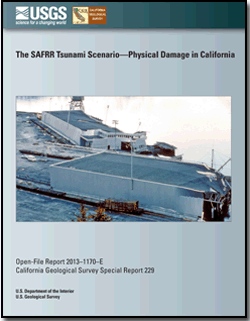 Introduction—Chapter Objectives Introduction—Chapter Objectives
This chapter attempts to depict a single realistic outcome of the SAFRR (Science Application for Risk Reduction) tsunami scenario in terms of physical damage to and recovery of various aspects of the built environment in California. As described elsewhere in this report, the tsunami is generated by a hypothetical magnitude 9.1 earthquake seaward of the Alaska Peninsula on the Semidi Sector of the Alaska–Aleutian Subduction Zone, 495 miles southwest of Anchorage, at 11:50 a.m. Pacific Daylight Time (PDT) on Thursday March 27, 2014, and arriving at the California coast between 4:00 and 5:40 p.m. (depending on location) the same day. Although other tsunamis could have locally greater impact, this source represents a substantial threat to the state as a whole.
One purpose of this chapter is to help operators and users of coastal assets throughout California to develop emergency plans to respond to a real tsunami. Another is to identify ways that operators or owners of these assets can think through options for reducing damage before a future tsunami. A third is to inform the economic analyses for the SAFRR tsunami scenario. And a fourth is to identify research needs to better understand the possible consequences of a tsunami on these assets. The asset classes considered here include the following:
-
Piers, cargo, buildings, and other assets at the Ports of Los Angeles and Long Beach
-
Large vessels in the Ports of Los Angeles and Long Beach
-
Marinas and small craft
-
Coastal buildings
-
Roads and roadway bridges
-
Rail, railway bridges, and rolling stock
-
Agriculture
-
Fire following tsunami
Each asset class is examined in a subsection of this chapter. In each subsection, we generally attempt to offer a historical review of damage. We characterize and quantify the assets exposed to loss and describe the modes of damage that have been observed in past tsunamis or are otherwise deemed likely to occur in the SAFRR tsunami scenario. Where practical, we offer a mathematical model of the damageability of assets exposed to loss. Then, applying the damageability model and the velocity, wave amplitude, and inundation models discussed in other SAFRR chapters we offer a single realistic depiction of damage. Other outcomes are of course possible for this hypothetical event. Where practical we estimate repair costs and estimate the duration required to restore the assets to their pre-tsunami condition. We identify opportunities to enhance the resiliency of the assets, either through making them less vulnerable to damage or able to recover more quickly in spite of the damage.
Finally, we identify uncertainties in the modeling where research would improve our understanding of the underlying mechanisms of damage and loss or otherwise improve our ability to estimate the future impacts of tsunamis and inform risk-management decisions for tsunamis. However, it is certain that the kinds of damages discussed here have occurred in past tsunamis, even in developed nations, and in a sufficiently large event, will occur in California. Our uncertainties can operate in either direction, either leading to an overestimate of damage or an underestimate. Therefore, losses in an actual future tsunami could be greater than depicted here. Furthermore this evaluation is not intended to be an exhaustive depiction of what could happen in this or similar tsunamis. Other impacts could occur that are not presented here.
|
First posted September 3, 2013
This report is presented in Portable Document Format (PDF); the latest version of Adobe Reader or similar software is required to view it. Download the latest version of Adobe Reader, free of charge. |